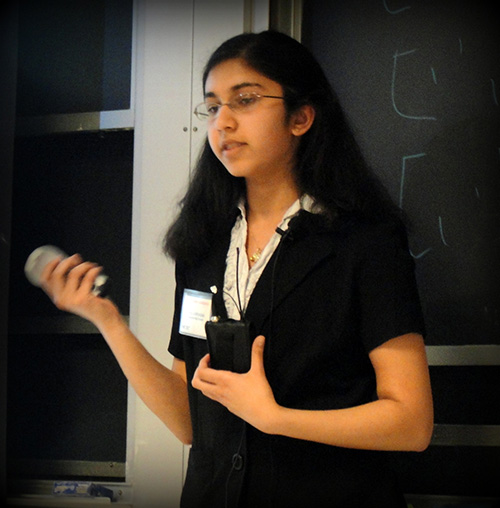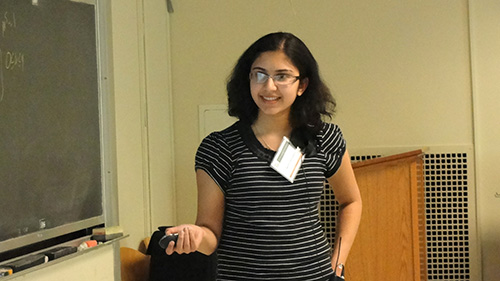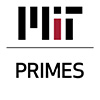 PRIMES: Devadas Interview
PRIMES: Devadas Interview
Interview with Sheela Devadas, by Susan Ruff
The following interview was conducted in the fall of 2014, after Sheela Devadas was awarded the Alice T. Schafer prize for Excellence in Mathematics by the Association for Women in Mathematics. It was reprinted in the Association of Women in Mathematics Newsletter, vol. 45, no. 5 (September-October 2015): 15-20.

Sheela Devadas was a PRIMES student in 2011 (joint project with Carl Lian Modular representations of Cherednik algebras associated to symmetric groups; mentor Steven Sam) and in 2012 (individual project Modular representations of Cherednik algebra; mentor Steven Sam). She presented her math research at the 2012 MAA Undergraduate Student Poster Session and published it in J. Commut. Algebra 6 (2014). She graduated from MIT in 2015 and entered a doctoral program in math at Stanford University.
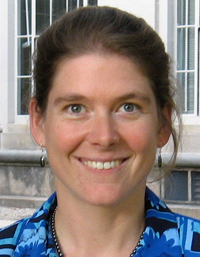
Susan Ruff is a lecturer for Writing Across the Curriculum in the MIT Mathematics Department. She teaches mathematical communication in undergraduate communication-intensive mathematics classes (CI-Ms). She is also an editor of the Mathematical Association of America's Mathematical Communication website.
SUSAN RUFF: Congratulations for receiving the Schafer prize for Excellence in Mathematics!
SHEELA DEVADAS: Thank you. It was a surprise when my advisor, Professor Etingof, told me. The initial e-mail went to my spam folder.
SUSAN RUFF: The criteria for the prize include interest, performance, and independence in mathematics. What fostered these for you?
SHEELA DEVADAS: In middle school I had a really good math teacher, Tatyana Finkelstein, who encouraged me to participate in programs like PRIMES and the PROMYS summer program at Boston University. In these programs, your research is guided but the work is your own to some degree. Obviously you have to ask questions, because when high school kids start PRIMES, they don’t really know that much about advanced math like representation theory. Having regular meetings with your advisor, but still having the ability to do independent work on your own, really helps to develop confidence.
Sheela at the First PRIMES conference, May 2011. Photo by Slava Gerovitch.
How PRIMES introduces students to research
SUSAN RUFF: In PRIMES, what is the role of the mentor?
SHEELA DEVADAS: I had a really good graduate-student mentor, Steven Sam, and the research was supervised by Professor Etingof. My mentor was really dedicated to the project. We met about once a week and I would tell him what I had been doing during that week in particular. I usually had at least a few questions and he would help with the answers, because obviously he has a lot more background than I do. So answering questions was a big role of the mentor—but also suggesting directions if I seemed stuck, without doing the proofs for me. When it came time to write the paper, a lot of the initial sections and background was his work, but then the subsequent sections were all my work. So a lot of what the mentor does is giving you a base to build off.
SUSAN RUFF: For people who don’t know, can you briefly describe what PRIMES is and how it works?
SHEELA DEVADAS: PRIMES is a program for high school students to participate in real math research (they extended it to Computational Biology and Computer Science as well). For the math program, you submit an application which involves some pretty difficult math problems; I think they have become more difficult since I applied to PRIMES in its first year. Then in January you get assigned to your project and a mentor. Sometimes there will be other students working on the same project. Initially Carl Lian was working on the same project as me, but he graduated from high school before I did. After that I was working mostly by myself.
Depending on the project, you might have to do some background reading first. I had to learn linear algebra and abstract algebra because I didn’t know anything about those at the time. I was just taking calculus. So depending on the project, there’s a month to three months of background research; your mentor will guide you through it. My mentor told me what books to read and assigned me some problems from the books to type up so that I could also learn LaTeX. Once I got to a stage where I could understand what the research problem is, we started having regular meetings to actually work on the research problem. Then in May there’s a PRIMES conference where everyone presents a short PowerPoint about their project so far and where it may go in the future.
SUSAN RUFF: Who was the audience for that conference?
SHEELA DEVADAS: It was mostly the other PRIMES students and the other PRIMES mentors, but it’s open to all of MIT. I’ve been to several PRIMES conferences as presenter and more recently as an audience member (because my sister was participating and somebody had to take a video). It’s pretty interesting to see the work that the high school students are doing. It’s impressive in a lot of ways, including the other fields like Computer Science and biology, though they separate the days of the conference by field now. In recent years they have also introduced reading groups, but I don’t know how those work because I have never participated in them.
Sheela at the Second PRIMES conference, May 2012. Photo by Slava Gerovitch.
Advantages and challenges of collaboration
SUSAN RUFF: When you started out, you had someone else working on the research with you and then you were working on it by yourself. Were you working on the same problem the whole time?
SHEELA DEVADAS: Carl was working on one case of the problem while I focused on a separate case. We did have meetings together initially, especially when we were doing the background reading for the research problem. Once Carl graduated from high school and went to MIT, we started meeting separately because I was still in PRIMES and his work was through MIT’s UROP program.
SUSAN RUFF: Can you describe the difference between working with someone else and working individually? Is it useful to do joint projects in math?
SHEELA DEVADAS: It’s definitely useful, especially when you are starting out. I didn’t know all that much about the subject at the time, so it was useful to have other people around who could tell me if I was doing something that was just incredibly off base for whatever reason. You start out with a lot of assumptions and then you have to pare down the assumptions, but then there are other assumptions that you need to make that I wouldn’t have necessarily made. Group work is pretty different, because talking to people and bouncing ideas off each other feels really different from just writing all this algebra down on scratch paper.
SUSAN RUFF: In what ways?
SHEELA DEVADAS: It’s different when you’re writing up on the board and somebody else can see something you wouldn’t necessarily have seen. Also, it’s somewhat slower because you do have to explain to other people what you were thinking a lot more often than when you are doing individual work, which is one of the difficult things. But then it’s also useful because everyone has a different perspective on the project.
SUSAN RUFF: Do you find that when you write a paper it’s helpful to have had that experience of trying to explain?
SHEELA DEVADAS: Yes. Definitely. Writing it down is explaining to people, although there is a degree of separation between you and the people you’re explaining to.
SUSAN RUFF: Do you have a preference—if you have a choice—between working on a project by yourself or working on it with someone else?
SHEELA DEVADAS: It depends. Having the mentor guiding me has been really useful. But I do prefer to work independently most of the time, simply because I think I understand my own thought processes a lot better than I understand other peoples’ thought processes. Sometimes I have no idea where people come up with their ideas, so when it comes to what is the motivation for this idea, I have no idea—because somebody else came up with it.
SUSAN RUFF: Let me know if I understand correctly: it sounds like although it’s useful to have the experience of trying to explain to other people because that helps you when it comes time to write the paper, in the stage of idea generation it sounds like it slows you down a bit and you might prefer to do the idea generation by yourself. Maybe interacting with others after the ideas are generated might be more helpful and more efficient.
SHEELA DEVADAS: That’s the way I work. I know for other people it really depends on how introverted or extroverted they are. I’m a fairly introverted person so my idea generation works best internally. But there are definitely other people who generate ideas best when they are bouncing them off other people.

Five tetrahedra in the regular dodecahedron. Every even permutation of these tetrahedra is implemented uniquely by a rotation. Model by Sheela Devadas. Photo by Dennis Porche.
Why math research is rewarding
SUSAN RUFF: Can you articulate what it is about math research that you enjoy?
SHEELA DEVADAS: Well in math competitions, somebody has already solved this problem. Many people have already solved this problem and they have probably solved it in a simpler and better way than I am capable of. With math research, though, it’s the idea that I might be the first person ever to have understood a particular concept in a novel way. If I can articulate that understanding, I am increasing the knowledge pool of the world in some sense, even if it doesn’t necessarily have immediate applications to something most people consider useful. It’s just interesting to push the frontiers of human knowledge.
The research problems are more difficult than math competitions but that’s what makes them more interesting. They have a greater depth; there isn’t just one trick like you can use to solve a lot of math competition problems. You build on previous work but also have your own original ideas.
I haven’t done math competitions since high school because I really didn’t enjoy them all that much. Competition doesn’t really appeal to me: I don’t like having conflicts with people. In math competition, while you can sit down and do practice problems with your friends, at the end of the day you enter the competition separately and one of you will probably get a better score than the other. But I like research—while working with other people sometimes can slow you down, collaboration is definitely better than competition. With research you can sit down and work on research problems with your friends and then you go away and work on them independently. Then you come together and talk about it, and both of you learn something.
Also, I like research in math in particular because nothing stands between you and your ideas: you aren't relying on physical substances that can and will go wrong. I had an experience with science fair, growing plants, that did not go well: in all pots, most plants died, so we couldn't draw any conclusions. In math the things you're researching don't generally keel over.
SUSAN RUFF: Did you have any experience with research before doing PRIMES?
SHEELA DEVADAS: A little bit. It was more guided independent work. In middle school, Tatyana Finkelstein would do things like tell us to think about multiplying points in the plane without telling us that that the purpose was to figure out how complex numbers worked. She taught us about abstract algebra by having us consider symmetries of different shapes. It was like guided research in some ways because she would point us in a certain direction and then we worked together within the class and by ourselves until we got to this math concept. That’s why I understand complex numbers well. I remember sitting down one day and painstakingly proving that when you multiply two complex numbers the angles add and the radii multiply. That was a lot of fun. When I actually learned about it in high school, I was like “The polar form of complex numbers makes a lot of sense to me now!” A lot of her students end up doing PRIMES or other programs, because she really pushes people to do interesting math.
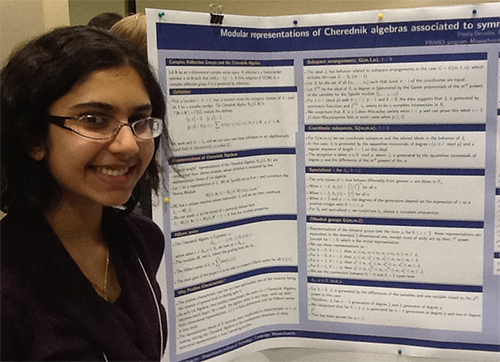
Sheela presents at the MAA Undergraduate Student Poster Session of the Joint Mathematics Meeting, January 2012. Photo by Alison Miller.
Advice for future PRIMES students
SUSAN RUFF: You started doing math research in the PRIMES program while you were still in the 10th grade. Do you think it’s a good idea to start doing research so early? What challenges did you face in PRIMES and how did you cope with them?
SHEELA DEVADAS: I think it’s a good idea to figure out if you want to do research early, because it’s a different mindset than other fields and math competitions. But, like I said, I didn’t even know what linear algebra and abstract algebra were when I started doing research—I had a lot of background to catch up on. My mentor helped by emailing me some exercises to do from each chapter of the book. Doing the exercises was the important part. If I had just read the book, I don’t think I would have really understood what was going on at all.
SUSAN RUFF: Do you have any suggestions for future PRIMES students who need to learn a body of material like that?
SHEELA DEVADAS: Do exercises, but not just the ones that are assigned to you by your mentor, because you never know what’s going to end up being applicable to your project later. I kept having to go back at other points during the project to learn other concepts. I had to do a lot of reading during the project, so it was also very important to learn how to read math. That’s a separate skill that should be cultivated at the same time as learning the background concepts.
SUSAN RUFF: Do you have any advice for PRIMES students for how to read math?
SHEELA DEVADAS: I would start at a low level and move upwards. Textbooks are one thing, but then papers are an entirely different beast, because the papers aren’t necessarily designed to teach. They’re designed to tell the math community about this thing that the author found. Start with more advanced textbooks than you know and then start with papers that are written well. Papers that are not written so well should come last.
While you read, keep a scrap sheet of paper next to you, so you can write down words you don’t know. Most of the math definitions on Wikipedia are correct, so if you don’t know what a “module” is and you’ve encountered this word for the first time you should probably just look it up on Wikipedia. Also, when you’re reading math, the proofs often skip algebra steps. So if want to actually understand what’s going on, it’s useful to work through the algebra yourself on the scrap paper. Sometimes knowing why the algebra works out gives you a more intuitive understanding of what’s going on with the theorem.
Once you’re done with it, you should try to summarize what you think you’ve learned, so that you can make sure that you figured it out. If you can’t summarize it, then you should probably read it again.
SUSAN RUFF: Once you’re done with the background reading and are doing the research, do you have any strategies for idea generation that you would suggest to other PRIMES students?
SHEELA DEVADAS: I read as much of the previous work that I can find—both work I have done and that other people have done—and I look for cases that are similar to see if I can generalize. I ask people who know more about the subject than I do when it’s necessary. It helps to break the problem into smaller parts. If you’re trying to prove something that’s huge, just focus on a case like n = 3 first and see if that’s slightly easier to deal with. Then try n = 4. If there’s a big similarity between those cases, then you can probably generalize it.
SUSAN RUFF: Do you have other advice for PRIMES students?
SHEELA DEVADAS: You should know that you are going to be dedicating a lot of time to this project, and even time that you’re not really aware of dedicating. I spent a lot time thinking about the project when I was doing other things: when I was eating, or when I was in the shower. If that’s happening, it’s definitely a good thing, because it means that you’re really working on it. You should want to think about the project—if not, you should probably try spending more time working on it. If the project is just not interesting to you then you should maybe talk to your mentor about why it’s not interesting to you at this time and how to move forward. I was interested in my project all the way through because there was just so much information to take in. It was a lot of fun.
SUSAN RUFF: You were doing this at the same time as doing all of your regular high school classes?
SHEELA DEVADAS: Yes. I was doing regular high school classes the whole time. Then I took some classes with Harvard Extension because, after calculus, my high school didn’t offer any other math courses. The project was useful when I got around to taking linear algebra as a class: I already knew a lot of things, but not everything, obviously.
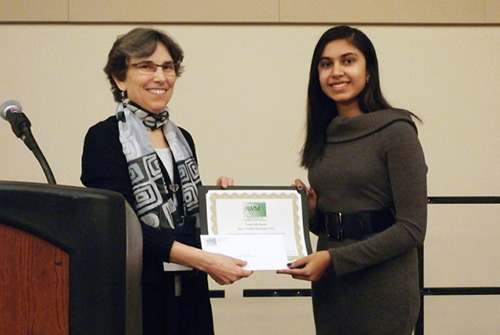
Sheela receives the Alice T. Schafer Prize for Excellence in Mathematics from Professor Ruth Charney of Brandeis University, then president of the Association for Women in Mathematics. Photo by Magnhild Lien/Association for Women in Mathematics.
Being a woman in mathematics
SUSAN RUFF: The Schafer Prize is awarded by the Association for Women in Mathematics and it’s named after one of the Association’s founding members, who contributed a great deal to women in mathematics throughout her career. Do you have any observations about your experience as a woman in PRIMES and at MIT?
SHEELA DEVADAS: There were other girls doing projects in PRIMES, but most of the people I interacted with on my project were guys. I didn’t really notice it when I was in PRIMES.
When I got to college, it took a little while, but eventually I did get used to being the only girl in the room a lot of the time. Most guys don’t really care that you’re a girl. Most of my professors I don’t think really cared or noticed, or it wasn’t really relevant. But then sometimes you do encounter the occasional person who will says things like “girls aren’t generally good at math” and they’ll remember that you’re there and say “present company excepted, of course.” In one way, people forgetting is a good thing and then in other ways it means they might say things without necessarily thinking about them.
I think college may not be the place where the real bottleneck of girls going into STEM happens. I think the career doesn’t work for a lot of women for some reason, and neither do earlier levels, like middle school. I was the only girl on the math team in middle school a lot of the time. Gender politics in middle school are really awkward.
For me so far, being at MIT has been the best time to be a woman in math because people don’t really seem to care. At MIT, girls who do math and science are treated as normal. It’s unusual to be a person who doesn’t like math or science at MIT. But not necessarily everyone in high school likes math and most of the girls in high school aren’t really into math. You end up feeling lonely because there’s a “bro” culture in some high school math competitions (and even in middle school). I didn’t notice that culture as much in college, because I moved away from math competitions in general.
SUSAN RUFF: Do you have any suggestions for how to encourage girls in math?
SHEELA DEVADAS: It really helped that my middle school math teacher, who encouraged me in math, was a woman. Because it told me “Wow, it’s actually totally normal for girls and women to be into math.” Just having a peer group of other girls, and having mentors who are women who have been a success in their field is really important. I’ve had two research projects since I’ve come to MIT and I’ve enjoyed both of them a lot, but I think that my research adviser who was female was able to tell me things men just don’t necessarily know about the experience of women in academia. It’s important to have mentors and have a peer group, regardless of whether it’s through an official capacity. I think it’s important to support things like the Math Prize for Girls competition (that’s for high school girls) and MIT’s Undergraduate Society of Women in Mathematics.
Research after PRIMES
SUSAN RUFF: How did being in PRIMES affect your thinking about the future?
SHEELA DEVADAS: By the end of my first year of PRIMES, I realized that math research was what I wanted to do for a career. It was a lot more interesting than math competitions and any of the math I was doing in high school. So by the time I went to college, I already knew that eventually I wanted to get a PhD and pursue research. It helps that my dad is a professor so I have some idea what academic research looks like from an outside perspective. It always seemed to me that he really enjoyed his job. I know we’re similar in temperament and I thought I’d really enjoy it too.
SUSAN RUFF: Tell me about the research you’ve been doing at MIT.
SHEELA DEVADAS: My first project was a continuation of what I was doing in PRIMES. I wrote up everything I had done so far into a paper with my mentor. I think that the journal is actually going to publish this paper now.
SUSAN RUFF: Congratulations!
SHEELA DEVADAS: It’s pretty exciting. I might actually buy a print copy. I don’t get print copies of most of my mathematics things—I usually just read them on the computer. Now I’m working on a continuation of the work, dealing with a different case. My previous mentor, Professor Etingof, is still the official supervisor for the project, but I’m now working with Yi Sun, a graduate student at MIT.
In between, for a few years, I went into an entirely different field with Professor Ronitt Rubinfeld of CSAIL, working on a project about homomorphism testing. The idea is that you want to test if a program computes a homomorphism but you don’t want to have to make too many queries to this program. We have a program-testing algorithm for which the number of queries is independent of the size of the domain. Which is interesting, because by making a constant number of queries we’re able to see something about the accuracy of the program on the whole domain, because it’s a homomorphism, which has the property that f(a) + f(b) = f(a + b). It’s a linearity test, essentially. It’s pretty cool. I presented it at the Electrical Engineering and Computer Science Conference last year as a poster and we’re working on writing it up into a paper now. It’s been a lot of fun.
SUSAN RUFF: Was that your first conference other than the PRIMES conferences?
SHEELA DEVADAS: I also presented my PRIMES research at the 2012 Joint Math Meetings poster session in Boston. That was an experience. I think it went pretty well. Putting things together into a poster and trying to explain it to other people is useful for making sure you know what’s going on. Somebody told me once that to know if you truly understand a math concept you have to explain it to someone else. The poster sessions were fun in that sense. Some of the people in the PRIMES poster session—I think they were family members of some of the other PRIMES students—didn’t know what I was talking about. That happens. When I practiced my PRIMES presentation on my own family I am pretty sure they didn’t know what I was talking about either. My dad was pretty happy when I did my second project in linearity testing because he’s a computer scientist so he could follow along.
Closing words
SUSAN RUFF: Thank you very much for doing this interview. Is there anything else you’d like to say to the MIT or PRIMES communities?
SHEELA DEVADAS: Math is fun and a lot of people think you’re weird for thinking that math is fun. That’s an experience I’ve had a lot. But you’re not weird. There are lots of other people who love math and the community is really great and supportive. So become a part of the greater math community. It’s a nice place.
Contact
With questions, contact PRIMES Program Director Slava Gerovitch at

